Using Process Capability for Statistical Evaluation of Cleaning Processes
Pharmaceutical Technology's In the Lab eNewsletter
This study examines the use of process capability index results to establish sampling strategies for new product cleaning and to minimize the risk of insufficient cleaning.
muuraa/shutterstock.com

Pharmaceutical development requires time and enormous cost, which can be an economic burden to pharmaceutical companies. Pharmaceutical companies, therefore, have been striving to make improvements, and since the 2000s, they have been focusing on activities such as operational excellence. Operational excellence is a concept proposed by M. Treacy and F. Wiersema in 1995, and it is one of the three competitive strategies for leading companies: operational excellence, product leadership, and customer intimacy (1). Many US and European firms, mainly major electronics manufacturers, employ operational excellence to reduce costs by optimizing processes. In firms where operational excellence is already implemented and the operation improvement process is well-established, a competitive edge can be assured. It is also considered that in such firms, the idea of constantly pursuing better operations is communicated to and understood by all personnel on site, and a mechanism that enables continuous improvement is already well established.
Operational excellence is just one of the concepts of task-improvement methods such as total quality management and Lean Six Sigma; the application to pharmaceutical products to minimize product risk has been limited and can be extremely difficult to implement. To strengthen the competitiveness of pharmaceuticals, it is necessary for the pharmaceutical industry to carry out discussions with a wide range of perspectives not only in research and development (R&D) but also in manufacturing. Despite the many challenges that must be addressed (e.g., pharmaceutical sensitivity to changes in the manufacturing process, complicated manufacturing methods, the need to meet high-quality requirements), few case studies discuss these manufacturing processes (2). In recent years, these issues have been discussed in the pharmaceutical industry, but in many cases, the manufacturing processes--including processes from API to finished pharmaceutical manufacturing from a holistic standpoint-have not been clearly identified. While biopharmaceuticals such as antibody drugs are greatly advanced in product development and technology, bioprocesses have variable factors that are distinctive to their processes. These factors attract the interest of regulatory authorities, and the highest priorities have been given to compliance with good manufacturing practice (GMP), safety, etc., which has caused a lag in research and manufacturing to provide pharmaceuticals more efficiently and economically without sacrificing the quality.
The demands for quality engineering methods are increasing globally, and the establishment of a system to carry out continuous process improvement is required to supply high-quality formulated products throughout the product lifecycle. The International Council for Harmonization (ICH) published three guidelines: Q8 Pharmaceutical Development (3), Q9 Quality Risk Management (4), and Q10 Pharmaceutical Quality System (5). The International Society for Pharmaceutical Engineering (ISPE) published a baseline guide called Risk-Based Manufacture of Pharmaceutical Products (Risk-MaPP) in September of 2010, which provides a scientific, risk-based approach, based on ICH Q9 to manage the risk of cross-contamination in order to achieve and maintain an appropriate balance between product quality and operator safety (6). These guidelines, however, are mainly conceptual, and the realization of these concepts is left up to each pharmaceutical company.
Methodologies established in other industries (7) have been gradually spreading in the GMP environment to identify and understand pharmacological and toxicological risks and help ensure drug safety. In this research, a new method that could efficiently improve the manufacturing process by applying a quality engineering framework is examined and proposed as a more advanced methodology to improve the control strategies of manufacturing cleaning processes in biopharmaceuticals including antibody drugs, by utilizing risk management and scientific knowledge more widely.
Statistical analysis of cleaning process data
The manufacturing process of antibody drug substance is a combination of unit operations. Several reactors of different sizes are used in the culturing process, while chromatography systems and many tanks are used in the purification process. These processes often have multiple pieces of equipment with large areas to clean.
The most common cleaning process used to maintain the cleanliness of biopharmaceutical manufacturing equipment is cleaning with dilute sodium hydroxide as a cleaning agent, which is then followed by a sterilization step using high-pressure steam. Because it is necessary to maintain the cleanliness of manufacturing equipment after manufacturing activities for hygiene and quality control reasons, clean-in-place (CIP) and steam-in-place (SIP) are the major methods used. These methods clean the inside of the complex piping systems and tanks by running the cleaning agents through them followed by high-pressure steam without disassembly of the equipment. Parameters such as frequency and time of cleaning are optimized by measuring the actual residual amounts of product remaining on the equipment as found through swab, rinse, and other testing methods. For areas where cleaning may not be carried out effectively due to insufficient flow rate, a method to fill the system with a cleaning agent and holding it for a certain period time is applied.
After reviewing and organizing existing cleaning data obtained from the actual equipment used in the biopharmaceutical manufacturing, an evaluation of cleaning performance was conducted to confirm that the cleaning was effective in preventing cross-contamination, and to ensure consistent performance of the cleaning operation.
For a process in control, the ability of the process to consistently achieve the desired level of quality (specifications) is called process capability (Cp). Cp is a simple, straightforward comparison of the spread of the process data (variability) to the spread of the specification limit for that process data. Basically, it is a measure of how well the data fit within the specifications. The calculation of Cp is shown in Equation 1:
Equation 1

Sometimes data are not centered within the specification range and are significantly closer to one specification limit than the other. In these cases, a modification of the Cp calculation is used that only looks at the distance of the mean to whichever specification is closest to the mean. This is called the process capability index (Cpk). Also, for data that have no lower specification limits (such as cleaning data), a variation of the Cpk can be used instead that calculates a Cp based on only one specification. This is the Cpu (upper) and is also a simple comparison of the spread of the data (its variability) to the distance from the data mean to the upper specification limit. In a cleaning process, the Cpu is determined using only an upper specification limit because cleaning processes are carried out so as to reduce the residual amount of pharmaceuticals, cleaning agents, etc., to the level below an acceptance limit. The calculation for the Cpu can be seen in Equation 2.
Equation 2
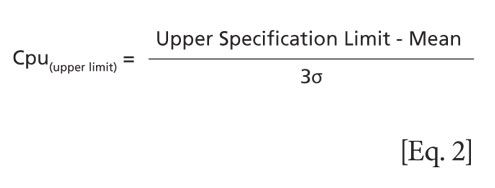
When evaluating the cleaning process capability, therefore, the mean values and the standard deviations used in the formula should be those derived from the cleaning data, and the process capability index (Cpu) of the cleaning process will be defined by Equation 3.
Equation 3
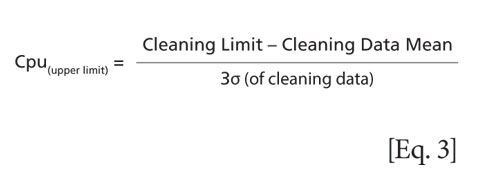
In this study, the capabilities of the cleaning processes were statistically evaluated using the Cpu. The manufacturing equipment for antibody drug substance were classified into equipment groups based upon their manufacturing cleaning processes. First, the cleaning data of the products were converted into a percentage of their cleaning limits because these actual values are confidential and could not be used in this article. After that, the mean values, the standard deviations, and the Cpus were derived (see Table I).
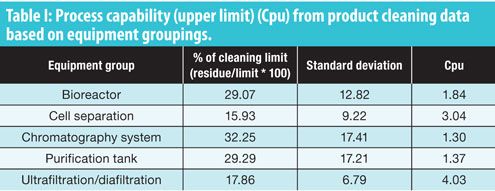
The bioreactor group, harvest group, and ultrafiltration/diafiltration (UF/DF) group had high Cpu values indicating that the capability of cleaning process was good. On the other hand, the Cpu values of the chromatography system group and the purification tank group were lower compared to the other groups, although their data still fell below their cleaning limits.
The many horizontal and U-shaped piping pieces with smaller than 25.4 mm of diameter used in the chromatography system make these systems difficult to clean; this is considered to be the reason the Cpu value of the chromatography system group was not as high as the other groups. It is also presumed that the reason for relatively low Cpu value of the purification tank group was due to the relatively large variability in data, which was probably caused by various process tanks with capacity of over 2000 L and wide surface area that comprise this group.
A proposed Cpu-derived limit based on “overall cleaning performance”
Statistical evaluation of the capability of the cleaning process can be viewed from two directions. The first direction is whether the cleaning process is capable of removing the substance subject by cleaning to a level below a limit based on the acceptable daily exposure (ADE); which is synonymous with the permitted daily exposure (PDE), as used in the European Union. This viewpoint is suitable for evaluating if the target substances being cleaned can be removed to a level that ensures the safety of patient based on the cleaning limit of the substances subject to cleaning. This evaluation is particularly essential for commercial plants in which several items are manufactured.
Another viewpoint can be considered useful for evaluating the facility’s overall cleaning performance, regardless of the cleaning limits of the substances that are subject to cleaning; this approach is new to the pharmaceutical industry. The effectiveness of process evaluation based on “overall cleaning performance” will be examined in this section.
If Equation 3, which is used to derive the Cpu, is rearranged, a minimum desired Cpu could be substituted into the equation along with the known cleaning data parameters and a limit based on process capability calculated for use in all subsequent cleanings (Equation 4).
Equation 4
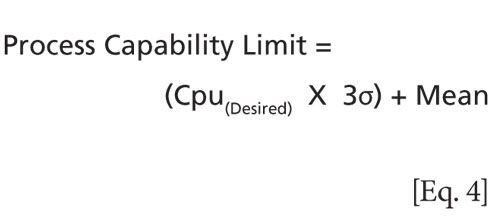
In other words, the desired Cpu becomes the starting point for calculating a limit for all residues on all product contact surfaces. For example, if the desired Cpu is 1.33, in Equation 4, it can then be used to define the analytical limits for swab sampling for all products. This approach would be particularly useful and easy to apply in a manufacturing facility where the analytical method is common (e.g., total organic carbon [TOC]), where all the manufactured products are similar (e.g., Immunoglobulin Gs that have a common molecular structure), and where the difference in cleanability between products is expected to similar.
Such a process capability limit can be easily and quickly calculated for all equipment groups for any possible desired Cpu (Table II). A process capability limit provides a single limit for target equipment group and avoids the difficulties of using multiple limits based on the ADE, which will vary from product to product (Figure 1). The suitability of these process capability limits can be reinforced by incorporating ongoing cleaning data into the calculations from different antibody drug substances employing the same cleaning processes. Such continuous improvement of processes based on the accumulation of process understanding is completely consistent with the basic concept of FDA’s 2011 process validation guidance.

Figure 1. Process capability limit and acceptable daily exposure (ADE)-based limits. TOC is total organic carbon. (Figure courtesy of authors)

Summary
At first, the capability of cleaning process was evaluated for an antibody drug manufacturing facility using the Cpu, which is one of the common methods to evaluate the process capability in quality engineering. Consequently, the authors succeeded in evaluating the capability of the cleaning processes for all equipment used in the actual production by classifying the equipment into groups. The study demonstrated that the cleaning process for bioreactor group, cell separation group, and UF/DF group had high process capabilities. It also indicated that the chromatography system group-which is a purification process with a combination of unit operations and having a structure that is difficult to clean-and the purification tank group had relatively low Cpu values compared to other groups, yet they still fell within their cleaning limits.
It is also generally known that in the purification processes of antibody drug substances the purified antibody proteins are likely to adhere onto the process equipment due to the process characteristics mentioned in this study and product properties, making them difficult to clean.
Acknowledgement
The authors would like to thank Prof. Shuichi Yamamoto of Yamaguchi University for his helpful suggestions and insightful comments.
References
1. M. Treacy and F. Wiersema, The Discipline of Market Leaders: Choose Your Customers, Narrow Your Focus, Dominate Your Market (HarperCollins Publishers Ltd, 1995).
2. H. Sugiyama, “Business Model of Continuous Improvement in Pharmaceutical Production Processes,” presentation at the 23rd European Symposium On Computer Aided Process Engineering, 2013.
3. ICH, Q8 Pharmaceutical Development (ICH, August 2009).
4. ICH, Q9 Quality Risk Management (ICH, November 2005).
5. ICH, Q10 Pharmaceutical Quality System (ICH, June 2008).
6. ISPE, Baseline Guide: Risk-Based Manufacture of Pharmaceutical Products (Risk-MaPP), First Edition (ISPE, September 2010).
7. DaimlerChrysler Corporation, Ford Motor Company, General Motors Corporation, Production Part Approval Process, 4th Edition (Automotive Industry Action Group, 2006).
Article Details
Pharmaceutical Technology
Vol. 42, No. 5
May 2018
Pages: 48-51
Citation
When referring to this article, please cite it as T. Kaminagayoshi, et al., "The Statistical Evaluation of Cleaning Processes Using Process Capability and its Application to New Product Introduction," Pharmaceutical Technology 42 (5) 2018.
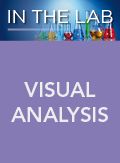
Transformations in Drug Development for Cell and Gene Therapies
March 28th 2025As a recognized leader in immunophenotyping for clinical trials, Kevin Lang from PPD discusses how spectral flow cytometry is transforming drug development, particularly in cell and gene therapies like CAR-T. He also dives into his award-winning research, including his 2024 WRIB Poster Award-winning work, and his insights from presenting at AAPS PharmSci360.
Advancing Clinical Trials with Spectral Flow Cytometry: A Conversation with Kevin Lang
March 28th 2025As a recognized leader in immunophenotyping for clinical trials, Kevin Lang from PPD discusses how spectral flow cytometry is transforming drug development, particularly in cell and gene therapies like CAR-T. He also dives into his award-winning research, including his 2024 WRIB Poster Award-winning work, and his insights from presenting at AAPS PharmSci360.
Pharmaceutical Tariffs Are Imminent: How Industry is Bracing for Impact
April 16th 2025On April 14, 2025, the Trump Administration launched a national security-driven investigation into pharmaceuticals, a move that will likely result in tariffs being placed on pharmaceutical drugs, ingredients, and other components that are imported from outside of the United States.